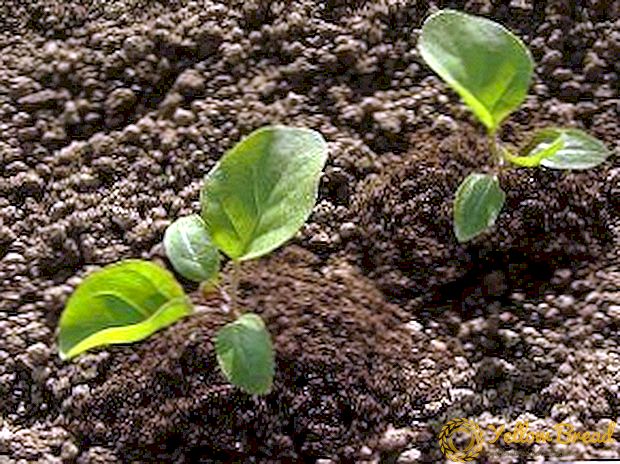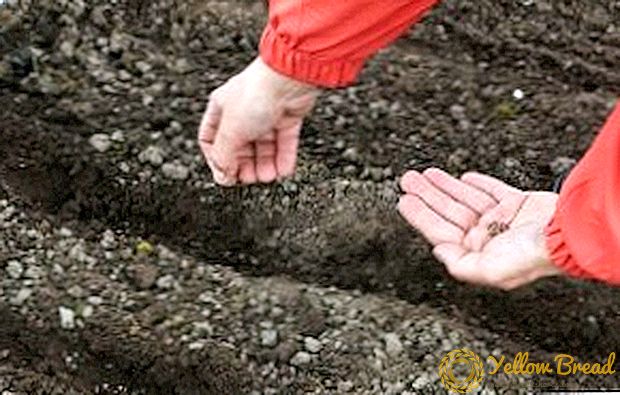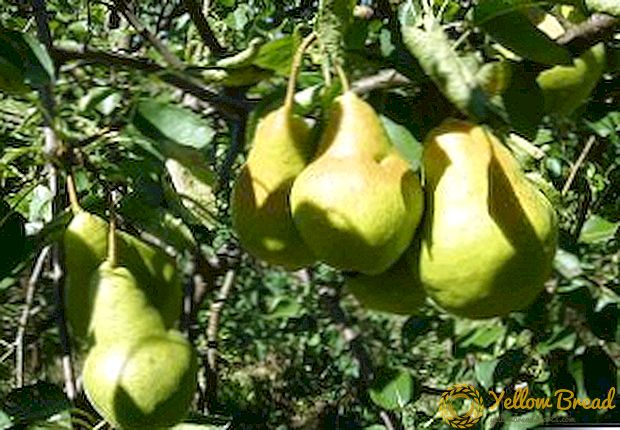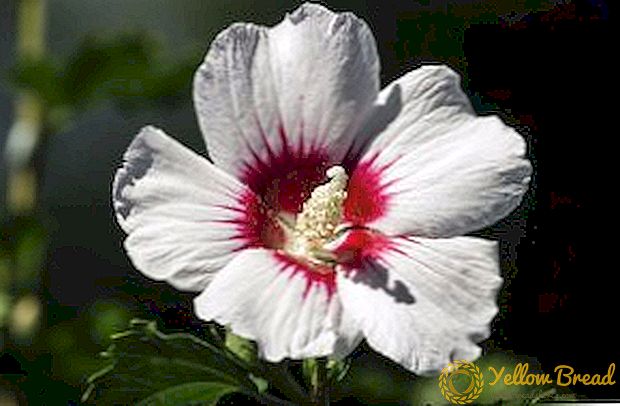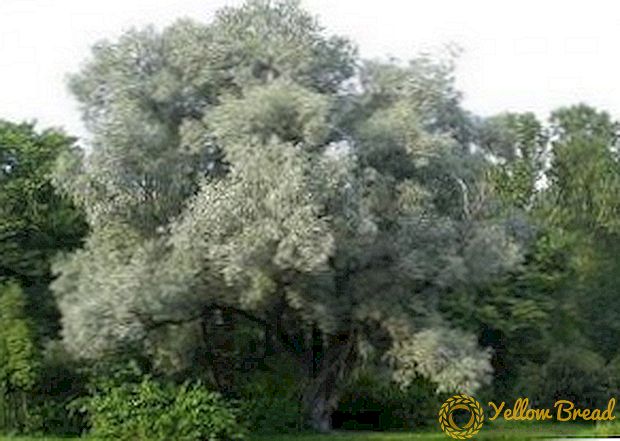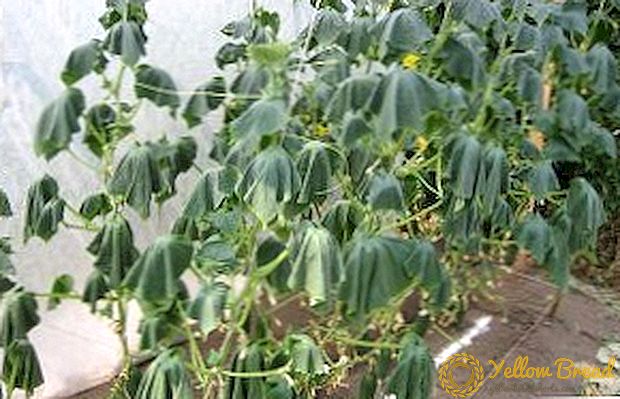 Evergreen plant up to 2.5-3 meters with large leaves and vaguely reminiscent of a palm tree is castor. The type of plant is quite unusual, which attracts many gardeners and causes a desire to grow it.
Evergreen plant up to 2.5-3 meters with large leaves and vaguely reminiscent of a palm tree is castor. The type of plant is quite unusual, which attracts many gardeners and causes a desire to grow it.
- Castor Bean: Plant Description
- Growing castor bean, planting rules
- Choosing a place for planting the castors that you need for effective growth
- Landing rules
- How to care for a flower
- Rules for watering and feeding plants
- Features of soil care
- Pest and disease prevention
- Castor Bean Breeding
- Sowing seeds for seedlings
- Sowing seeds in open ground
The castorplate has some subtleties of planting and care in the open field, which is worth reading. It is common as a fast-growing ornamental plant, and is also an oil-bearing and medicinal plant.
By creating all the favorable conditions for the development of the plant, you can get a great decoration for the garden, yard, plot. Also castor can perform functional load - for example, to be part of the hedge.
Castor Bean: Plant Description
 There is only one type - castor bean. These palm-like plants for a garden in our latitudes grow up to three meters in height, and in natural conditions of subtropics and tropics, castor can reach 10 m. Flowers have a powerful appearance, are hardy and do not require serious care. With such a decoration of the garden you can easily recreate the atmosphere of subtropics.
There is only one type - castor bean. These palm-like plants for a garden in our latitudes grow up to three meters in height, and in natural conditions of subtropics and tropics, castor can reach 10 m. Flowers have a powerful appearance, are hardy and do not require serious care. With such a decoration of the garden you can easily recreate the atmosphere of subtropics.
In the tropics and subtropics castor grows as an evergreen shrub. The stems of the plant are erect, branchy. The inner part of the stems is hollow, sometimes red, pink, purple or almost black in color and covered with a bluish wax coating.
Castor bean leaves reach 30-80 cm in length, have deep incisions, uneven teeth, pointed tips. In the middle of summer, inflorescences of reddish or green flowers appear.
 On the same castor plant there are both male and female inflorescences. Male are located in the lower part of the stem, female - at the top. The flowers themselves are white or light cream in color.
On the same castor plant there are both male and female inflorescences. Male are located in the lower part of the stem, female - at the top. The flowers themselves are white or light cream in color.
The fruit of the plant is a spherical bare or barbed box with a size of 3 cm in diameter. Fruits give the plant a decorative appearance, located between the leaves.
Seeds ripen in fruits. They have a smooth, mosaic, shiny shell. Mosaic can be pink, light pink, brown. The background under the mosaic also comes in different shades - from gray to copper red.
Castor oil is produced from castor oil, which is well known in medicine and cosmetology.
Growing castor bean, planting rules
The castor is not too whimsical plant, and those who want to know how to grow it, you need to follow only a few recommendations. On the state of the plant, its development affects the place chosen for cultivation.Open areas with constant air movement - this is something that will appeal to the castor.
 It is possible to cultivate castor from seed at home. To do this, you need to pick a deep, narrow pot - the plant will not grow too high and will form a beautiful bush. If in the summer the pot can be kept on the street, then with the arrival of frosts it should be put in the heat.
It is possible to cultivate castor from seed at home. To do this, you need to pick a deep, narrow pot - the plant will not grow too high and will form a beautiful bush. If in the summer the pot can be kept on the street, then with the arrival of frosts it should be put in the heat.
Choosing a place for planting the castors that you need for effective growth
Castor oil is a heat-loving plant. Choosing a place for its landing, you need to take this into account. The place should be well illuminated, otherwise the plant will stretch into growth and break, especially if there are strong winds. Because of the lack of sun, castor oil will not have time to form seeds or will not bloom at all.
Favorable are the south-eastern side of the site. Castor oil can develop in partial shade, but in the sun the leaves become glossy, with a reddish tinge. If the sun is not enough, the leaves become saturated green.
You can locate plants on the site in various ways. The most popular options are as follows:
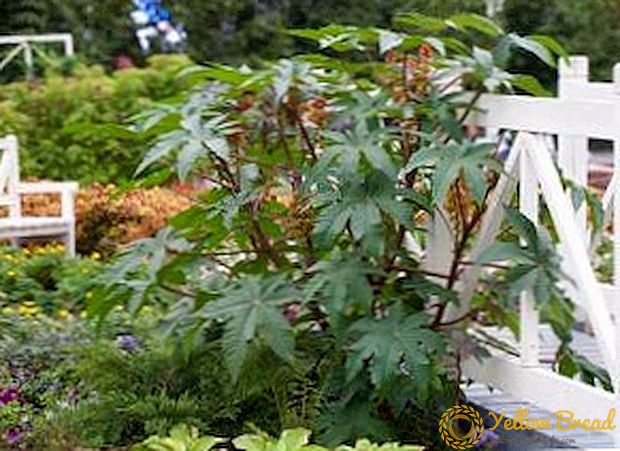 Before entering the house;
Before entering the house;- As a hedge around the perimeter of the plot (the distance between plants in this case can be reduced to 80 cm);
- Single landing on the site;
- As a plant tapeworm in the center of the lawn, flower beds.
Despite the fact that the plant is high, the root system is not very powerful, although it has a large taproot.
When disembarking, choosing a place, it is necessary to take into account the size of an adult plant. A castor can be high, sprawling, therefore the radius of the place must be at least a meter. When planting several plants in one place, for growing a bush, a place in a radius must be at least one and a half meters.
Landing rules
Cold temperatures harm the plant, so the cultivation of castor in areas with temperate climates is possible only by seedling. Directly in open ground can be planted in regions with warmer climates.
 The main feature of the plant is a very small percentage of germination of crops and a long time of germination. When seed planting, if you do not carry out preliminary preparation, seedlings will appear in 2-3 weeks. To speed up this process, seeds need to be rubbed with sandpaper before planting.Thus, the integrity of the shell is broken, after which the planting material must be soaked in a special solution overnight.
The main feature of the plant is a very small percentage of germination of crops and a long time of germination. When seed planting, if you do not carry out preliminary preparation, seedlings will appear in 2-3 weeks. To speed up this process, seeds need to be rubbed with sandpaper before planting.Thus, the integrity of the shell is broken, after which the planting material must be soaked in a special solution overnight.
Castor bean seeds can be sown in one of two possible periods for this. If we consider how to plant castor oil on seedlings, then it is necessary to sow in March or April. In case of sowing in open ground, this can be done in May, when the temperature is consistently high.
How to care for a flower
In the right place for a plant, it is much easier to care for it. The following points are important: proper watering, maintaining the soil in good condition, fertilizing and preventing diseases.
Rules for watering and feeding plants
 The castor bean is watered often. She does not like drought, especially during the flowering period. At this time every morning you can water it with a bucket of water.
The castor bean is watered often. She does not like drought, especially during the flowering period. At this time every morning you can water it with a bucket of water.
Before planting, fertilize the soil well with organic fertilizer. It is necessary to dig a hole to a depth of 40 cm and place manure on its bottom. Planted above the plant. When it comes time before the formation of inflorescences, it is good to make nitrogen. When the brush of a flower is laid, potash phosphate fertilizers are applied.Also for castor bean it is good to dust the soil with ashes. Throughout the summer, once every two weeks, it can be fed with fertilizer for flowering plants.
Features of soil care
The castorina grows quickly, in a year it can grow up to two meters. The composition of the soil should be well treated, loose and with a sufficient amount of nutrients. Soil - gray or black, containing sand and clay soils are not suitable.
It is especially important when planting seeds to ensure that the soil is sufficiently loose. For planting make up the soil of equal parts of humus, turf and leaf land. But you can prepare the land from the garden or take the purchased land for seedlings.
Pest and disease prevention
The castor does not like weeds, especially carefully it is necessary to deal with them while the plant is still young. In the fragile cast iron age it is difficult to overcome the weeds on their own.
 As for pests, they do not affect castor bean. Therefore, it is not required to treat the plant with any chemical preparations. But diseases can affect castor oil. For the prevention of their occurrence, the seeds of the plant must be harvested from healthy cultures, they must be cleaned and treated. During the growing season, the plant is sprayed with 1% Bordeaux liquid or similar preparations.
As for pests, they do not affect castor bean. Therefore, it is not required to treat the plant with any chemical preparations. But diseases can affect castor oil. For the prevention of their occurrence, the seeds of the plant must be harvested from healthy cultures, they must be cleaned and treated. During the growing season, the plant is sprayed with 1% Bordeaux liquid or similar preparations.
Castor Bean Breeding
The casting of the castor is seed. They ripen in several pieces in the fruit. There are two main ways to plant castor seeds. They are sown on seedlings at home, followed by planting in open ground or immediately sown in open ground. Both of these castor bean breeding methods have several features. They are used at about the same frequency, since both are effective.
Sowing seeds for seedlings
 Often castor goes through cultivation from seed to seedlings. In March-April, at home it is sown in separate pots. Immediately, separate containers are needed - this is a fast-growing plant and the seedlings are quite large.
Often castor goes through cultivation from seed to seedlings. In March-April, at home it is sown in separate pots. Immediately, separate containers are needed - this is a fast-growing plant and the seedlings are quite large.
To obtain good seedlings requires preliminary preparation of seeds. Deepen the seed in the ground to a depth of 2 to 6 cm.
The castor, the sowing of seedlings which was produced in early April, develops into a powerful plant. Planted seeds covered with a piece of cloth, and put the container in a well-lit place.
Only when it becomes noticeably warmer, can it be transplanted into open ground. This is usually June.In order for a sapling to settle down well after transplantation, it must be taken with a clod of earth in which it sprouted.
Sowing seeds in open ground
 Sowing castor beans with seeds immediately in open ground is also a popular method. In order to carry out such a landing, you must wait for a stable temperature not lower than 12 degrees. This is usually the middle of May.
Sowing castor beans with seeds immediately in open ground is also a popular method. In order to carry out such a landing, you must wait for a stable temperature not lower than 12 degrees. This is usually the middle of May.
Seeds need to prepare for planting to make it easier to germinate. In the ground, the seed is deepened by 2-10 cm. 1-3 seeds can be placed in one well, as there is a chance that not every one of them will germinate.
It is good to sow the castor in the open ground, if you arrange a greenhouse above it. This contributes to the growth of stronger seedlings. The castorplate will decorate any area, while not requiring a lot of time and effort to care.

 Before entering the house;
Before entering the house;